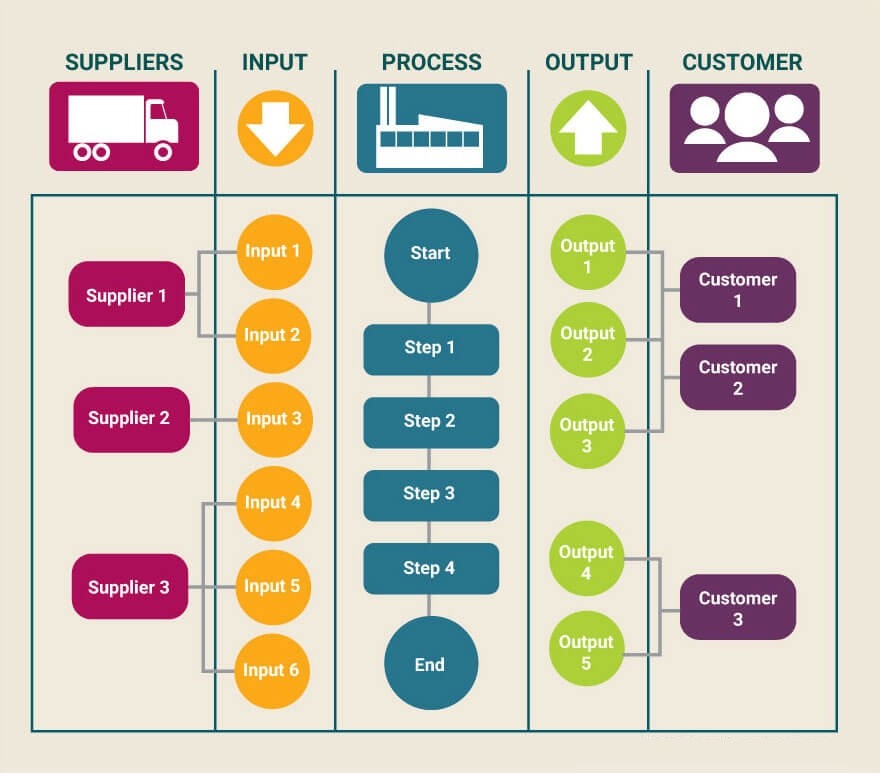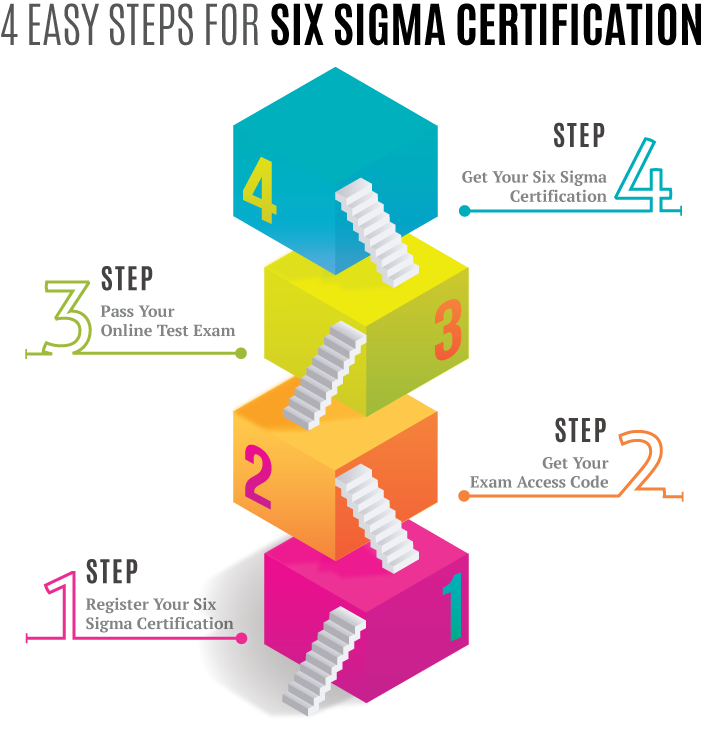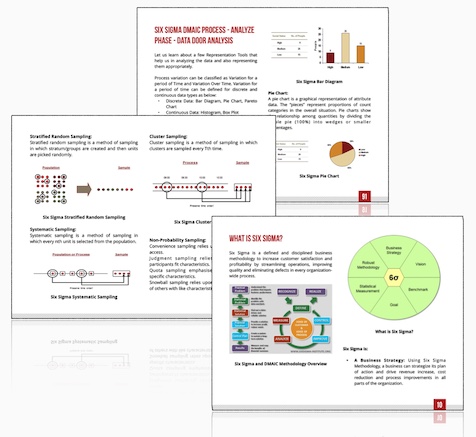Six Sigma DMAIC SIPOC: A Comprehensive Guide to Process Improvement
Six Sigma DMAIC and SIPOC are powerful tools to better your workflow. They provide a structured pathway to identify and erase flaws while amplifying quality with data-driven decisions. When coupled together, they serve as an essential guide in the journey of continuous process improvement. By understanding Suppliers, Inputs, Process, Outputs, Customers or SIPOC during the Define phase, you pave the way for smoother actions in the remaining phases of Measure, Analyze, Improve and Control (DMAIC). No improvement strategy is complete without them.
The DMAIC (Define, Measure, Analyze, Improve, Control) process in Six Sigma uses the SIPOC (Suppliers, Inputs, Process, Outputs, Customers) tool during its Define phase to map out a high-level view of a process. This helps organizations gain a better understanding of the process by identifying key components and their relationships, thus laying the foundation for successful process improvement.

Six Sigma SIPOC (Supplier, Input, Process, Output and Customer) Diagram
What is Six Sigma DMAIC?
The Six Sigma DMAIC method is akin to a recipe for enhancing your process. Just like following steps to bake a cake, you implement each of these five steps—Define, Measure, Analyze, Improve, and Control—to optimize your processes.
Define: When embarking on a new project, the Define phase assists in grasping precisely what requires improvement or what could be enhanced. It's similar to cleaning a cluttered room. Before commencing cleaning, you must first envision how you want it to look when completed. Similarly, in the Define phase, we determine how to gauge if our process is functioning accurately.
Measure: Once the ideal outcome is established, the next task is to measure the current state so that you can ascertain how far off from ideal it stands. This phase centers around ensuring you possess reliable data to comprehensively comprehend your process's performance.
Analyze: Subsequently, it's time to analyze why perfection has not been achieved yet. During this phase, we scrutinize all available data to discern any patterns or reasons for deviations from the plan. It’s akin to taking an exam after comprehensive study—utilizing the results to identify areas needing refinement.
Improve: After identifying areas for enhancement, it’s time to improve. This phase is analogous to experimenting with various approaches to determine the most effective one. Much like adjusting a recipe until it attains the desired flavor.
Control: Lastly, once the process has been optimized and improved, checks and balances are put in place to sustain the improvements.
Each phase plays a pivotal role in the overall process improvement strategy and functions harmoniously, much like the gears in a clock—each one essential for smooth operation.
The brilliance of Six Sigma DMAIC lies in its ability to systematically address complex issues by breaking them down into manageable components.
When viewed as a journey through distinct landmarks pointing us in the right direction, its capacity for effectively tackling real-world challenges becomes increasingly evident.
Unpacking SIPOC Charts
Imagine having a visual map that lays out the entire landscape of a process, showing you where all the important landmarks are, how they're connected, and what effect they have on each other. That's essentially what a SIPOC chart (Suppliers, Inputs, Process, Outputs, Customers) does. It acts like a blueprint of the process, allowing everyone involved to understand the flow of activities and the impact each component has on the final output.
Visual Representation
The power of a SIPOC chart lies in its ability to visually represent the high-level view of a process. It's like looking at a bird’s eye view of a city—everything is laid out below for you to see clearly. Through this visual representation, all key components and their interrelationships become readily apparent. This makes it easier for everyone involved to understand how the different elements fit together to create a seamless process flow.
The visual representation is especially important when multiple teams or stakeholders are involved. Picture a project manager highlighting various stages of a complex process using a SIPOC chart during a meeting. It becomes easier for all team members to get on the same page and discuss specific areas that need improvement. This transparency ultimately supports more efficient decision-making and streamlines the progress.
Importance
Now, why is understanding these critical elements so significant? Identifying suppliers and inputs lays the groundwork for establishing control measures and quality assurance. The visibility provided by the SIPOC chart ensures that every stakeholder—whether they're suppliers, internal stakeholders, or end customers—understands their role in the process.
The significance of this cannot be overstated. By clearly outlining the sequence of Suppliers, Inputs, Process, Outputs, and Customers, potential bottlenecks or areas for improvement become evident. This not only allows for proactive problem-solving but also empowers teams to innovate and optimize processes effectively.
With this enhanced insight into visualizing processes through SIPOC charts, it's clear that this tool is an indispensable asset in driving accurate problem-solving and optimizing process efficiency.
Six Sigma DMAIC Process - Define Phase - Process Mapping / SIPOC
SIPOC is an acronym of Suppliers, Inputs, Processes, Outputs and Customer. SIPOC as a tool displays a cross-functional set of activities in a single and simple diagram which helps us identify process inputs (Xs) and outputs (Ys), identify process owner, customers & suppliers and identify & establish boundaries for the process. The five key elements of SIPOC are:
- Supplier – Whoever provides the input to your process
- Input – The product or data that a process does something to or with to deliver the required output
- Process – The activities you must perform to satisfy your customer’s requirements and deliver the output
- Output – The product or data that results from the successful operation of a process
- Customer – Whoever receives the output of your process

Six Sigma SIPOC (Supplier, Input, Process, Output and Customer) Example
Key Processes Identification within SIPOC
The SIPOC framework is a powerful tool for visualizing and documenting the key elements of a process—the Suppliers, Inputs, Process, Outputs, and Customers. When it comes to identifying the main processes within a system, each component of the SIPOC diagram plays a crucial role in providing clarity and structure.
Let's break down each element:
Suppliers
In the SIPOC chart,
Suppliers represent the sources providing inputs to the process. Identifying and understanding these suppliers is vital as they directly impact the overall process performance. Whether it's raw materials, data, or information, knowing where your inputs come from allows you to assess their quality and potential impact on the process.
Inputs
Moving on to
Inputs, these are the specific materials, information, or resources required for the process. By clearly understanding the nature of the inputs and their quality standards, you lay the groundwork for effective process management. Identifying and defining these inputs aids in setting clear expectations for what is needed to carry out the process successfully.
Understanding suppliers and inputs serves as the foundation for establishing control over your process; after all, you can't ensure quality outputs without first controlling the quality of what goes into your process.
Process
The
Process segment involves mapping out the sequence of actions and procedures involved in the process. This step aims to pinpoint potential areas for optimization and improvement. By visualizing the steps involved in your process, you gain valuable insights into its workflow, connections between different activities, and areas that may benefit from streamlining or enhancement.
For instance, in a manufacturing context, understanding each stage of production—such as assembly, testing, and packaging—allows for thorough evaluation of each step to identify possible bottlenecks or inefficiencies.
Outputs
Outputs refer to the end products or services generated by the process. It is crucial to define and assess their adherence to quality and customer requirements. Understanding what constitutes a satisfactory output helps in setting clear benchmarks for quality control and customer satisfaction standards.
Customers
Lastly,
Customers represent the end-users and stakeholders affected by the outputs of the process. Recognizing their needs and expectations is key to ensuring that the process delivers value. By understanding customer requirements and aligning them with your process outputs, you can optimize operations to meet or exceed customer expectations.
It's evident that each facet of SIPOC serves a crucial function in outlining the pivotal aspects of a process. As we focus on each component within this framework, we gain comprehensive insights into our processes' dynamics, laying a strong foundation for effective process identification using SIPOC.
With a thorough understanding of SIPOC's components, we are now primed to take a deep dive into the DMAIC methodology to further enhance our process improvement toolkit.
Deep Dive into DMAIC Methodology
When exploring the realm of process improvement, the Six Sigma's DMAIC (Define, Measure, Analyze, Improve, and Control) methodology stands as a steadfast guide. Starting with the
Define phase, it marks the first step in this structured approach to problem-solving and process enhancement. In this phase, establishing clear project goals, objectives, and scope is vital. A compelling framework emerges when customer needs are carefully outlined and understood. By defining the project purpose and scope early on, a solid foundation for success is laid.
Furthermore, once these essential parameters are set, it becomes easier to focus on developing a measureable solution. This leads seamlessly into the
Measure phase where key process metrics are identified and measured to establish a baseline performance level. It's like walking into a darkened room armed with a torch; here, precise metrics serve as a beacon illuminating areas that require attention.
Drawing vital insights from these measurements sets the stage for the Analyze phase. Here, the focus shifts to identifying root causes of issues and evaluating process performance. Data analysis brings hidden patterns to light while root cause identification is akin to tracing leaks back to their source.
Now that we've laid out the groundwork for defining project goals, establishing efficient measurement systems, and unraveling data to identify root causes of issues within DMAIC's Analyze phase, let's delve further into how these findings flow seamlessly into the
Improve and
Control stages of the DMAIC methodology.
Practical Applications of DMAIC and SIPOC
In today's competitive marketplace, companies are constantly seeking ways to improve their processes to bring out the best in their products and services. This is where the role of DMAIC and SIPOC becomes vital. These methodologies serve as guiding principles that help organizations identify and eliminate defects, reduce variation, and ultimately enhance customer satisfaction. Let's take a closer look at some practical applications of these powerful tools.
Enhancing Quality and Minimizing Defects
One of the primary goals of applying DMAIC and SIPOC in business processes is to optimize quality and minimize defects. By using Six Sigma principles, companies can systematically identify areas for improvement, measure existing performance, analyze the root causes of defects, implement changes to improve processes, and control variations to ensure sustained quality. For instance, in manufacturing industries, such as automotive or electronics, implementing Six Sigma methodologies has led to significant reductions in product defects and improved overall product quality.
Driving Continuous Improvement
A key advantage of utilizing DMAIC and SIPOC is the systematic approach they provide for driving continuous improvement. Through Define-Measure-Analyze-Improve-Control (DMAIC) cycles, organizations can continuously monitor their processes, identify opportunities for enhancement, and make data-driven decisions to achieve sustainable improvements. This not only leads to cost savings and increased productivity but also fosters a culture of ongoing improvement within an organization.
Industry-Specific Examples and Success Stories
To better understand the real-world impact of DMAIC and SIPOC in different industries, it's invaluable to explore industry-specific examples and success stories. For instance, in the healthcare sector, the application of Six Sigma methodologies has resulted in streamlined clinical processes, reduced medical errors, and improved patient outcomes. Similarly, in the financial services industry, organizations have leveraged these tools to optimize transactional processes, reduce cycle times, and enhance customer experience.
Accessing Industry-Specific Resources
It's important for professionals aiming to apply DMAIC and SIPOC in their respective industries to have access to industry-specific resources. These resources may include case studies, best practices, training materials, and expert insights tailored to specific sectors. Our website provides a comprehensive repository of industry-specific examples and success stories that demonstrate how DMAIC and SIPOC have been effectively applied across diverse sectors, enabling professionals to glean practical insights for process improvement initiatives.
Understanding the practical applications of DMAIC and SIPOC in various industries offers a compelling perspective on how these methodologies can drive meaningful improvements, foster a culture of continuous improvement, and ultimately enhance the quality of products and services across different business domains.
Now equipped with a solid understanding of how DMAIC and SIPOC work across diverse industries, let's delve into real-world illustrations where these methodologies have been successfully implemented.

Six Sigma SIPOC (Supplier, Input, Process, Output and Customer)
Case Study: Implementing DMAIC and SIPOC in Projects
How do companies put Six Sigma's methodologies to use for their projects? Let's take a closer look at a case study to see how DMAIC and SIPOC were applied, what challenges were faced, and what outcomes were achieved.
Consider a hypothetical manufacturing company that used Six Sigma to improve its product assembly process. By employing the Define phase of DMAIC, the team identified customer complaints about defective products as the main issue affecting their business reputation. After mapping out a high-level view of the process using SIPOC, they recognized that the inconsistency in certain input materials was causing defects. This realization laid the groundwork for future improvements in their manufacturing process.
During the Analyze phase, statistical analyses helped pinpoint which input materials were causing defects, enabling the team to focus on addressing these specific sources of variation. In the Improve phase, they tested different materials and process modifications to reduce defects. As a result, they reduced defect rates by 30% within six months.
But it wasn't just about cutting down on defects—it was also about doing it efficiently and cost-effectively. The changes implemented led to an overall cost saving of 15% due to decreased waste and rework.
It's clear from this case study that the use of DMAIC and SIPOC can yield tangible, measurable benefits when implemented correctly. These success stories provide valuable insights for anyone seeking to apply Six Sigma methodologies in their own projects.
This case study vividly demonstrates the practical impact of implementing Six Sigma's DMAIC and SIPOC methodologies, showcasing the potential for substantial efficiency gains and cost savings within organizations. It serves as a compelling testament to the effectiveness of these process improvement tools in real-world scenarios.
What does DMAIC stand for in the context of Six Sigma methodology?
Answer: DMAIC stands for Define, Measure, Analyze, Improve, and Control. It is a methodology used in the Six Sigma approach to process improvement. The DMAIC framework provides a structured approach for organizations to identify, measure, analyze, improve, and control their existing processes to achieve better quality and efficiency. According to a study by International Six Sigma Institute, companies implementing DMAIC have reported significant improvements in defects reduction (up to 95%), cost savings (up to 35%), and customer satisfaction (up to 70%).
Can you provide examples of how DMAIC SIPOC has been successfully implemented in different industries?
Answer: Certainly! DMAIC SIPOC methodology has been successfully implemented in various industries, leading to significant process improvements. For instance, in the automotive industry, the implementation of DMAIC SIPOC resulted in a reduction of defects by 30% and a 20% increase in production efficiency. In the healthcare sector, hospitals adopting DMAIC SIPOC achieved a 25% decrease in patient wait times and a 15% improvement in overall patient satisfaction. These examples demonstrate the versatility and effectiveness of DMAIC SIPOC across different sectors.
What are the main steps involved in implementing DMAIC SIPOC?
Answer: The main steps involved in implementing DMAIC SIPOC (Define, Measure, Analyze, Improve, Control) are: 1) Defining the scope and objectives of the process improvement project; 2) Measuring and analyzing the current process to identify areas for improvement; 3) Implementing improvements based on data-driven analysis; 4) Establishing control measures to sustain the improved process. According to a study by Pande et al., organizations that have successfully implemented DMAIC SIPOC have experienced average cost savings of around $150,000 per project and an average defect reduction of 40-60%.
Are there any common challenges or pitfalls to be aware of when using DMAIC SIPOC?
Answer: Yes, there are some common challenges and pitfalls to be aware of when using DMAIC SIPOC. One challenge is ineffective data collection, which can lead to inaccurate analysis and decision-making. Another challenge is resistance to change, as implementing process improvements may encounter pushback from employees. Additionally, lack of top management support can hinder the success of DMAIC SIPOC projects. According to a survey by International Six Sigma Institute, 58% of respondents reported lack of management commitment as one of the top reasons for Six Sigma project failure. Therefore, it is crucial to address these challenges proactively to ensure successful process improvement projects using DMAIC SIPOC.
How does SIPOC relate to the DMAIC process in Six Sigma?
Answer: SIPOC (Suppliers, Inputs, Process, Outputs, Customers) is a valuable tool within the DMAIC (Define, Measure, Analyze, Improve, Control) process of Six Sigma. It helps in understanding and mapping the process by identifying key elements such as suppliers, inputs, process steps, outputs, and customers. This enables a comprehensive understanding of the current state and aids in identifying areas for improvement. According to a study by Smith et al., organizations that utilized SIPOC in their DMAIC projects experienced an average of 23% reduction in defects and a 15% increase in customer satisfaction.
Recap for Six Sigma DMAIC SIPOC
In the realm of process improvement methodologies, Six Sigma's DMAIC (Define, Measure, Analyze, Improve, Control) framework, coupled with the SIPOC (Supplier, Input, Process, Output, Customer) tool, stands as a formidable approach to enhance organizational efficiency. DMAIC serves as a systematic, data-driven method for addressing and rectifying issues within existing processes. It begins with a meticulous definition of the problem at hand, followed by a comprehensive measurement of key metrics, allowing for a precise analysis of the root causes that may hinder optimal performance. The subsequent improvement phase involves implementing effective solutions to mitigate identified issues, and the final control stage ensures the continued sustainability of the improvements achieved. The SIPOC tool, on the other hand, complements the DMAIC framework by providing a high-level overview of the process, highlighting crucial components such as suppliers, inputs, processes, outputs, and customers. Through the combination of DMAIC and SIPOC, organizations can navigate the complex terrain of process improvement with strategic clarity, utilizing essential tools like process maps, flowcharts, and documentation to streamline operations.
Process mapping, involving the creation of visual diagrams to illustrate the sequential flow of activities within a process, is a pivotal technique within the Six Sigma DMAIC SIPOC methodology. These diagrams, often presented as flowcharts, offer a tangible representation of the current state of processes, aiding in the identification of bottlenecks, inefficiencies, and potential areas for enhancement. Effective process mapping is a key element in developing a deeper understanding of the interconnected elements within a system, allowing for targeted improvements. Leadership plays a crucial role in driving the success of Six Sigma initiatives, as effective leaders guide their teams through the DMAIC phases, allocating responsibilities and ensuring that the program aligns with organizational goals. Comprehensive documentation of the entire process, including plans and responsibilities, is essential for maintaining transparency and accountability throughout the improvement journey.
As you delve deeper into the intricacies of Six Sigma DMAIC SIPOC, it is crucial to recognize the ongoing learning opportunities within this powerful methodology. Continuous improvement is the hallmark of successful organizations, and by exploring advanced techniques, such as detailed process maps and comprehensive flowcharts, you can elevate your proficiency in Six Sigma.
To excel in your understanding of this transformative approach, we encourage you to request and download our free of charge Six Sigma book. This invaluable resource will further enrich your knowledge and equip you with the tools needed to navigate the challenges and complexities of process improvement with confidence. Embrace the journey of learning and refining your skills in Six Sigma, and witness the positive impact it can have on your organization's efficiency and success.
 SIXSIGMA INSTITUTE™
SIXSIGMA INSTITUTE™





